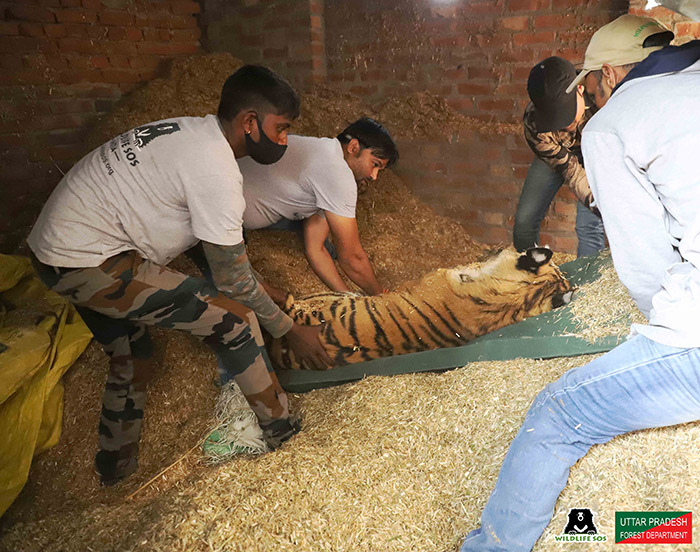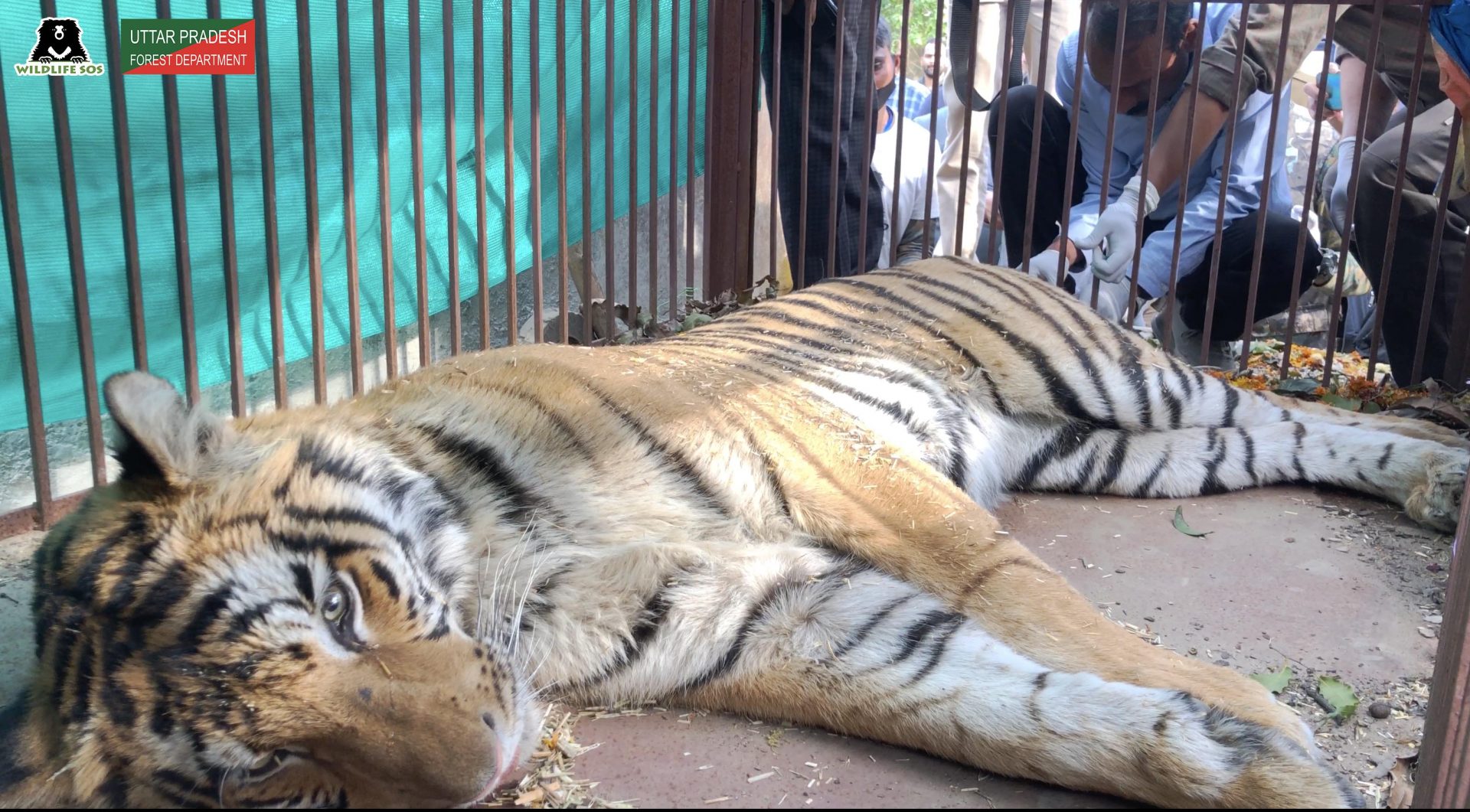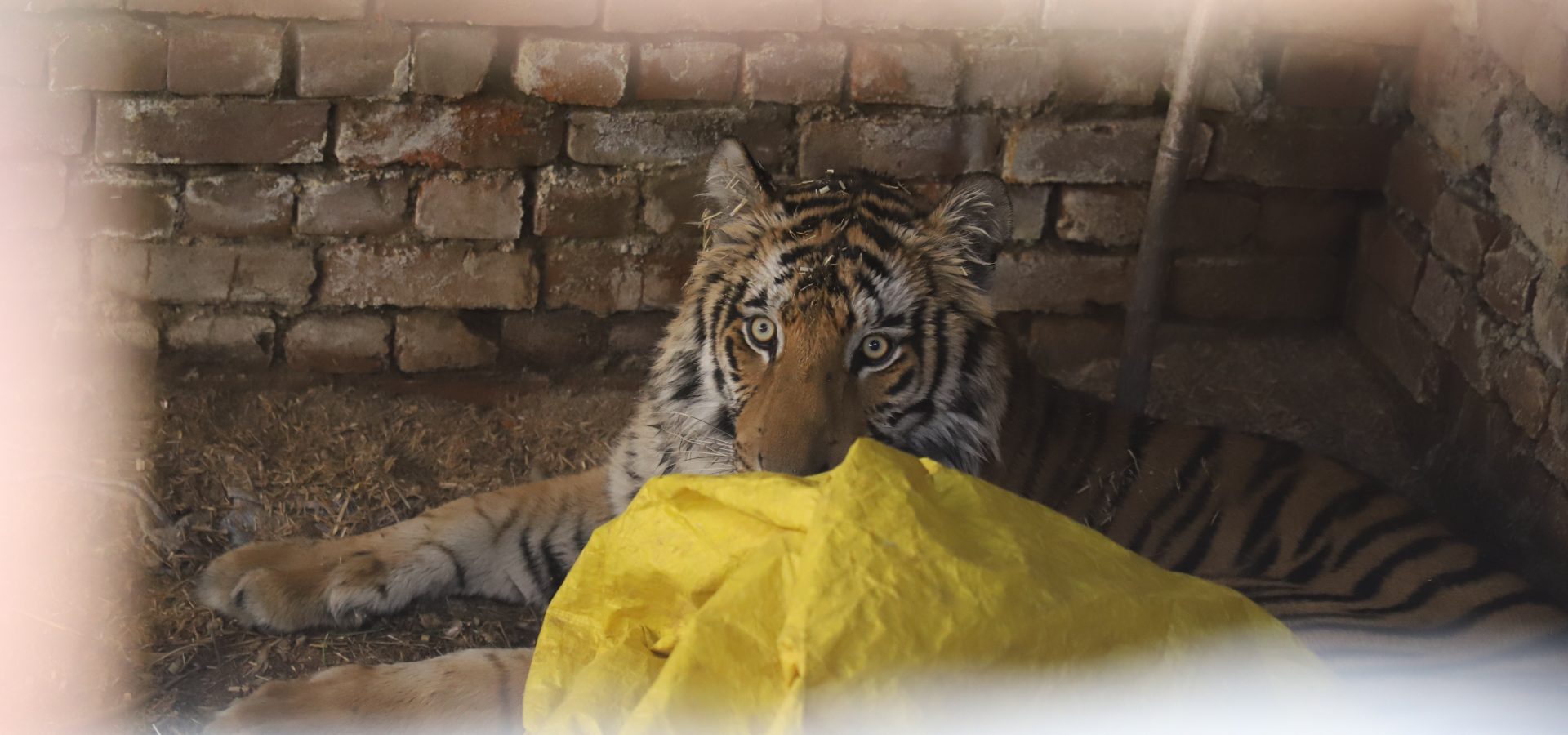In a rather unusual incident, a Bengal tiger was spotted on the roof of a cattle shed in the Etah district of Uttar Pradesh. While locals are accustomed to ungulate species wandering into the area, sighting a tiger seemed stranger than fiction. The encounter left the locals in a nerve-racking condition, who rimmed around the area in the blink of an eye.

A Nail-Biting Tiger Rescue
Residents of the village, Nagla Samal, immediately informed the Forest Department of the whereabouts of the big cat. For reinforcements, Wildlife SOS and Etawah Safari officials were called upon by the authorities. As the teams arrived in the residential area, they meticulously planned and initiated the joint rescue operation. While the rescue took place, an alarmed and inquisitive audience gazed with sheer anticipation. With over 3,000 villagers trying to get a glimpse of the tiger, stringent measures were implemented in order to avoid the crowd from getting out of control. Consuming a whole lot of patience, energy, and resources, the mission took almost eight hours to be completed successfully.
A Rapid Response Team of seven members led by Dr. Ilayaraja Selvaraj, the Deputy Director—Veterinary Services, Wildlife SOS provided its expertise and assistance in the operation. The teams located the tiger which was now inside the cattle shed and decided to carefully secure the area. First and foremost, they set up safety nets around the shed and the main exit point. The operation became a challenge due to an unclear view of the animal, thereby demanding comprehensive planning and coordination. Understanding the situation, senior veterinary officer, Dr. RK Singh, Dr. Sarvesh Rai from Etawah Safari, and Dr. Ilayaraja took their respective positions to secure the shed. Bricks from the shed wall were removed to tranquilize the tiger from a safe distance.

It took several attempts for the teams to successfully immobilise the tiger and following all safety protocols, the big cat was carefully shifted into a transportation cage. Veterinary experts stepped in for a regular health check-up, charting the vital signs. Aspects like body temperature and pulse rate are crucial to obtain an estimate of the feline’s present health condition. It was given on-site treatment for a minor injury on the tail. Found to be a female of an estimated age of not more than five years, the tiger is currently under medical observation at the Etawah Lion Safari.

Why Does A Tiger Stray In A Village?
Besides a massive human population, a variety of animal species also reside in the state of Uttar Pradesh. Tiger population has a stronghold in the state, spreading over two major Protected Areas (PAs) – Pilibhit Tiger Reserve and Dudhwa Tiger Reserve. Etah, a district in Uttar Pradesh, is a highly fertile landscape, situated between the rivers Ganga and Yamuna. With the population majorly relying on agriculture for their livelihood sustenance, crops such as rice, wheat, maize, and tobacco are grown in the alluvial floodplains across the area. Additionally being close to important tiger ranges, the area would make a suitable habitat for a tiger to stray in.
Burgeoning human population and never-ending habitat loss compel wild animals to live in close quarters with humans. Lack of habitat connectivity generally lures these big cats in human-populated regions. Tigers thus increasingly disperse to places outside the designated PAs. Moreover, regions with farmlands happen to provide dispersal routes to these wild tigers, even serving as potential breeding territories. Human-dominated landscapes are hoarded with a large number of livestock species, attracting tigers to regularly venture into the fields.
While many tigers prefer their forested range, some young tigers disperse into other landscapes in search of vacant territories and resources. As these large carnivores wander in human-dominated regions, it escalates the chances of interaction between two species. The odds of tigers and humans running into one another at close quarters are quite high in a state with over 170 tigers. While factors like deforestation and habitat degradation continue to reduce the forests to a narrow strip, these encounters become more and more common with each passing day. Oftentimes, humans also enter the densely forested regions to gather products such as fodder and fuelwood. Grazing livestock and collection of non-timber forest produce not just pose serious threats to biodiversity but also expose humans and their livestock to attacks by carnivores.
Resulting Human-Wildlife Conflict
Any conflict situation between an animal and a human being may arise when the needs and requirements of the two overlap, thus creating costs to both parties. Animals like tigers tend to get in more conflicts due to their massive home ranges and territories and the specificity of prey species. Conflicts arise from livestock depredation as well as human attacks, eventually developing a negative attitude about wildlife amongst the general public. In the long run, this impacts the support necessary for wildlife conservation, leads to retaliatory killings, and poaching.
Although humans and large carnivores have co-existed since time immemorial, a dramatic increase in conflicts has been observed in recent years. We owe this primarily to the exponential growth of the human population and resulting interactions. Space has become scarce, causing humans and wildlife to frequently engage in competition for space and resources. Cattle lifting is also recorded in numerous parts of the country due to the easily available livestock species. Tigers are even known to switch to a diet comprising livestock when the opportunity arises, regardless of the wild prey base availability. Thus making depredations on domestic animals the most common type of human-carnivore conflict.

Resource use overlaps make India a human-tiger conflict hotspot, with an estimated 50% of the global wild tiger population existing in only 11% of the globally available tiger habitat. These conflicts tend to be more frequent near forest edges at the interface of human and carnivore activity. Wild animals that spillover or disperse from source patches often have a negligible chance of surviving in corridors that generally provide low-quality, exposed habitat. When forced to range more widely in search of prey, they face greater exposure to anthropogenic threats including mortality on roads and direct persecution. In regions with high human population densities, tigers become susceptible to unfortunate encounters, attacks, and retaliation killings.
What Can Be Done About It?
While in certain areas, the two species co-exist peacefully, there is no denying the fact that conflict situations are on the rise. They continue to remain a major hamper in maintaining the momentum of increase and viability of the tiger population across the country. Human-tiger conflict in human-modified landscapes impacts the tiger numbers across their range. The periphery of Protected Areas, buffer zones, and corridor regions between subsequent PAs are more prone to interaction.
Recognising the magnitude of the problem, an improved conflict mitigation plan is generally put into practice. Increased vigilance, better guarding of livestock help aid the situation across the tiger distribution. Capacity-building measures such as improving knowledge of tiger presence, implementation of early warning systems would also minimise conflict and aid in management. Imparting education and awareness amongst the local communities ensure a better response to situations involving wildlife. Early interventions with additional technical and financial assistance significantly reduce the impact of the interaction.
With an encounter like the aforementioned, the prevalence of locals who act as first respondents played a crucial role. Strengthened coordination amongst the rescue teams and the strategic implementation of the plan resulted in a successful rescue mission. In order to carry out such a challenging operation, the teams indeed went above and beyond. Wildlife SOS is extremely grateful to the Forest Department and Etawah Safari officials for helping us make this rescue operation a success!





